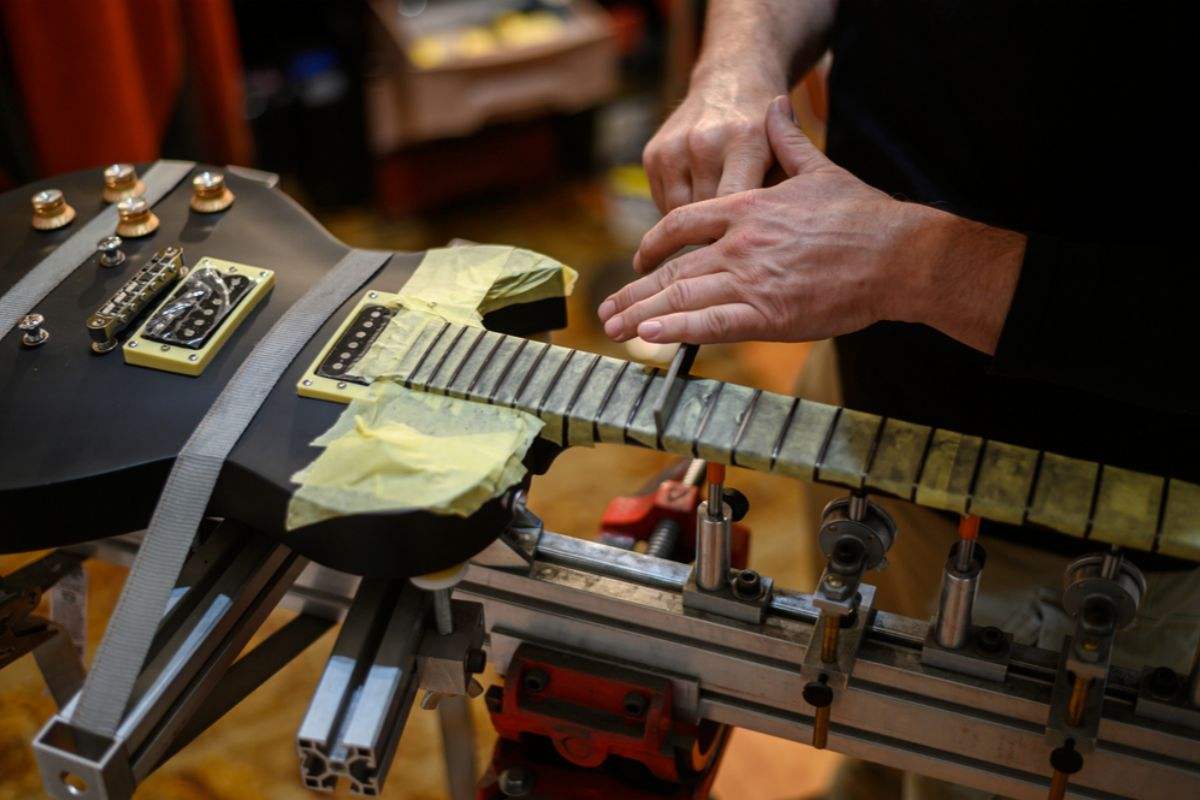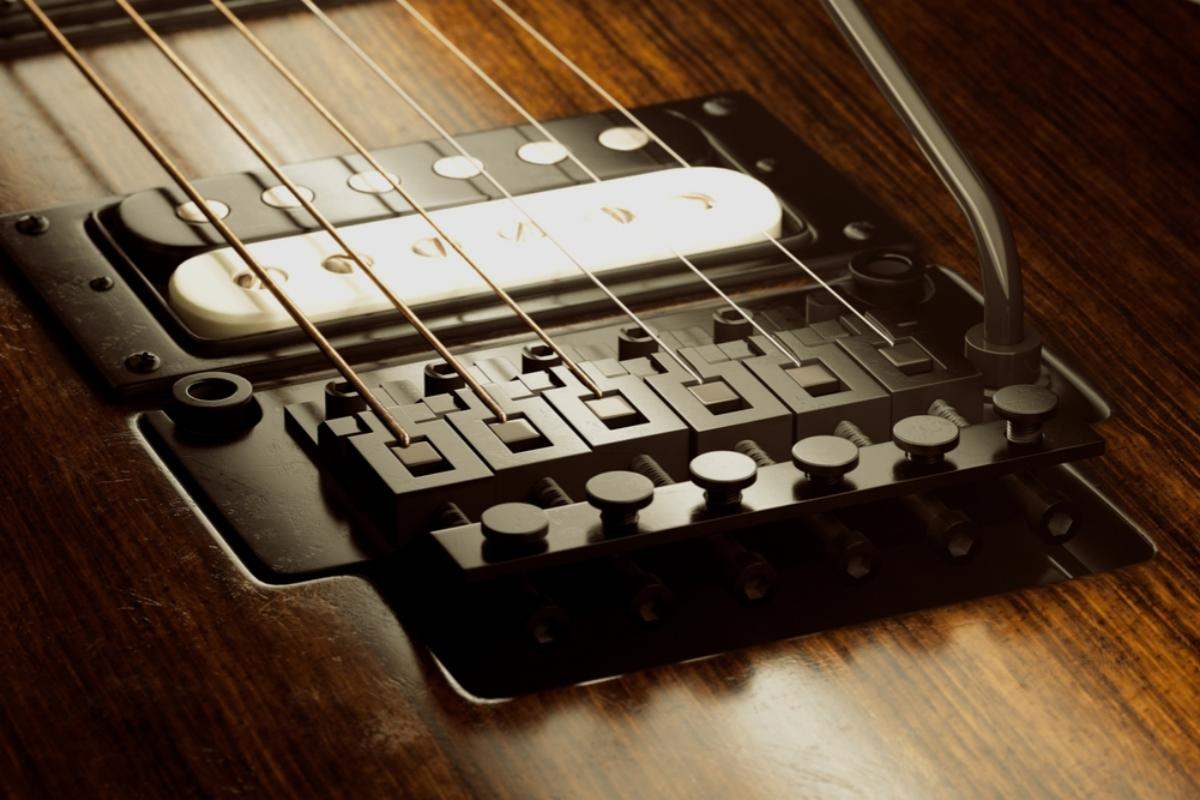Guitar electronics are the least visited of all the mysteries that make up guitar tone. Whether as a player, technician, luthier, guitar nerd, or aficionado, most of us overlook this important tone-shaping tool.
So, if you want to understand what lines like “CTS pots and orange drop caps” on ads mean or experiment to find the best guitar pots, this is the right place to be.
I’ll take you on a deep-dive journey to everything you always wanted to know about pots and caps and never dared to ask. So, buckle up because this once-in-a-lifetime journey to tone departs right now.
What is a Potentiometer?
A pot is a resistor. Turning the pot alters the electricity flow running through the resistance. This resistance is represented by a strip. As you move the shaft (the knob on the outside), you’ll modify the length electricity must cover to come out the other side of the pot.
The more resistance strip it’ll cover, the more gain it will lose on its way out. When you come close to zero, the gain loss will be total giving you just silence.
Potentiometer Types
Split or Solid Shaft?
Let’s start making the easiest differentiation first. What’s the difference between having a split-shaft or a solid-shaft potentiometer? Well, that difference only depends on the knob.
Split-shaft potentiometers usually work for plastic knobs. These are the best pots for Stratocasters. Solid-shaft pots work with metal knobs like the ones you’ll find in Fender Telecaster, for example. These knobs require a screw to stay in place.
Linear Pots
The name of these potentiometers says everything about the way they work. These pots are linear because they increase and decrease values linearly. This means that, for example, the number 10 on your guitar volume knob is 100% and the number 5 is 50%.
What does this mean to players? Well, they’re predictable and easy to use. What does this mean for a technician or luthier? That’s what comes stock in most guitars and what most musicians are used to.
Audio Taper Pots
Audio taper pots change their value in a non-linear fashion. Instead, they follow a certain logarithm. This means that the values on your guitar’s knob don’t necessarily have an exact correspondence to what you hear.
This works great for players who like going from dirty to clean with the twist of a knob. For example, you can have a drastic drop in gain in the first three points and play a full show between 6, 8, and 10 of your volume knob.
As a technician, this could be a cool suggestion for blues, rock and roll, neo-soul, and pop players who want to get more done with a single instrument.
Should Guitar Pots Be Linear or Audio Taper?
The answer to the question above depends on personal taste and performance. Now that you know the difference, it’s time to explore what sounds best for you and works best with your playing style.
One extra tip: you can recognize them with the letter A or B next to the pot value.
No-Load Pots
You might have heard about no-load pots. If that was followed by scratching the head with a pick thinking about what they are, this is for you.
No-load pots are just modded pots that allow you to remove the tone cap from the circuit when in 10.
Why would you want to have that on the guitar? Well, because it unlocks that extra percentage of raw tone and power your instrument can give you. As a technician, if your customer wants to unlock that pure-blood status of the guitar and have control over volume and tone, a no-load pot is the perfect solution.
When set to lower than 10, everything works, and when on 10, it’s in full-on mode.
Blender Pots
Finally, let’s talk about blender pots. Let me explain what they are with an example. Let’s say you have a Stratocaster but want that great neck + bridge combination only Telecasters offer.
Well, by having a blend pot instead of a second tone pot, you could blend in and out the neck pickup whenever you want. You won’t have telecaster pots and caps to mimic the exact tone, but it will give you one sonic option tone to play with.
Likewise, you could use a blend pot with any other pickup and guitar.
Pot Values
You must have heard the question “Should I use 500k volume and tone pots for my Les Paul?” Or maybe have seen countless forum users discussing whether Telecaster 500k pots are a good idea.
Well, to begin talking about this topic, let me say that there is no right or wrong. It’s a matter of experimentation and using your ears as a compass. That said, knowing what higher or lower resistances do to sound is a good shortcut to getting where you want to go faster.
A Simple Rule of Thumb
My rule of thumb for this matter is very simple. The closer you get to the number zero, the warmer the audio will be. Therefore, the opposite also happens, the more you move away from zero, the brighter it will be.
For example, you could say 500k pots are best for Les Pauls and 250k pots are better for Strats. This is because, in the first case, they add brightness to the big low-end of the Les Paul. In the second case, they tame the shrill highs in a Stratocaster.
But does that mean you can’t buy 500k pots for Strat? Well, of course, you can, maybe you even find a signature sound.
Believe me, besides the soldering time, it’s a very cheap tone experiment to do.
Volume and Tone Pots
I’ve heard the question “Is there a difference between volume and tone pots?” too many times in the past 3 decades I’ve been a player. The answer is no, volume and tone pots are essentially the same. The big difference is that tone pots have caps soldered on them to act as EQ.
What are Tone Caps?
Thank you for asking. The word capacitance refers to a component’s ability to store an electrical charge. Therefore, a capacitor is a tiny device that can hold electricity.
By using the knob that moves the shaft, you can dial in exactly the amount of electricity that goes through and how much stays.
How Do Tone Caps Work?
The way tone caps work is very simple. They just send certain frequencies to the ground, mostly the high-end, while impeding the low-end. That way, what you hear is that you’re rolling off the highs on the guitar. Those highs go to the ground and can’t be heard in the signal path anymore.
Tone caps are soldered between the ground (the top of the potentiometer) and the third lug. So, when turning it clockwise, the guitar’s tone is not affected and, by turning it counterclockwise, you can darken the instrument’s tone.
Values & Sound
Caps have different values. These values, measured in Microfarads, indicate how much of the guitar’s signal is rejected.
As a rule of thumb, you could say that the lower the measure, the subtler the effect. On the other hand, the higher the rate, the deeper the signal cut.
So, for example, if you want to tame a very bright pickup, like in a Telecaster, you can install a big cap. That’s why Fender’s approach was to use .02mfd, .047mfd, and .1mfd caps on their guitars. Gibsons, on the other hand, work with .022 mfd and .047mfd.
A .1mfd might make a Les Paul guitar too dark and muddy.
Here’s a great demonstration of the difference between cap values.
Capacitor Materials
Besides finding them in all sorts of values, you can also find capacitors made of a plethora of materials. The materials a capacitor is made of not only affect tone but also the variance between the specified value and the real value.
Ceramic
Ceramic capacitors are the most inexpensive and broadly used in guitars worldwide. Due to their cost, the most affordable guitars on the planet carry these capacitors inside. That said, you can also find them in vintage specimens.
Ceramic capacitors’ biggest con is that they have a tolerance of over 20%. This means you can get a .03mfd or a 0.15mfd when buying a .02mfd one. This also varies from guitar to guitar and makes them highly unpredictable.
Finally, ceramic caps might be microphonic.
Mylar
The next material is a polyester film named Mylar. They are a step up from the ceramic capacitors bringing the tolerance factor down to 5%. This means you get more consistency from one cap to the next making them more reliable and predictable.
Also, they tend to be less susceptible to any microphonic effects when compared to ceramic ones.
Polyester
The dielectric material in these capacitors is polyester film. They feature a very low tolerance of 5% or less, making them a predictable, reliable, top-notch option. Also, these capacitors offer excellent stability regardless of the temperature as well as low leakage.
This is the category where you’ll find Sozo Yellow Mustard caps and the utterly famous Orange Drops. These are caps known for preserving the guitar’s original tone.
Oil-Filled
The construction of these capacitors offers the player next-level insulation. This translates into superior signal integrity, less leakage, and enhanced clarity. Also, their self-healing properties make them durable and very reliable.
Finally, these capacitors offer a great feeling to the player because tone roll-off becomes smooth, organic, and natural.
Paper in Oil
These caps, also known as PIO caps, can be considered elite-level caps. This is mostly because of the way they sound. Yes, they offer a warm, vintage, rich tone that feels and sounds smooth.
Speaking of feeling, the response you get with the knob is also more natural and organic. They are famous for working the highs transforming them into harmonically rich, warm, round tones instead of shrill and piercing.
These are the kind of caps you can find in a Holy Grail vintage guitar, AKA a ’59 Gibson Les Paul. Yes, this is the category where you’ll find the famous Bumblebee caps.
Common Pots & Caps Pairings
Now that you know exactly what does what in your guitar’s circuit, it’s time to address some common pairings.
The right combination of guitar pots and caps will make your instrument sound more to your liking. Therefore, when thinking about this combination, you must think about what you like and what you don’t like about your guitar.
For example, if you own a maple-neck Stratocaster, you can install 250k or 100k pots with .047mfd caps and try to tame those highs.
On the other hand, if you have a muddy, bassy Les Paul, installing .02mfd caps and 500k pots could be a great choice.
For example, getting into the mind of one of the biggest guitar makers in history, did you know Jazzmaster pots and caps were originally 1Meg linear volume pot, 1Meg audio taper tone pot, and a .033mfd cap?
He used the 1Meg pots and .033mfd cap to give the Jazzmaster the ability to cut through the mix and be a lead instrument. If the brand installed 250k pots and .02mfd caps, the guitar’s natural low-end might get too muddy.
Although the best pots and caps for p90 pickups depend on your taste and tone pursuit, you know you need to install larger values for a brighter sound and lower ones for a darker, mellower tone.
The Bottom End
Pots and caps are the unsung heroes of guitar tone. They play a key role in shaping the tone before it reaches the output of the guitar. I hope you now have the tools to speed up your never-ending journey to tone heaven.
So, go ahead and experiment with different p90 pots and caps or install CTS 500k pots on that dark-sounding Telecaster.
Yes, tone pursuit is all about bold decisions and a good pair of ears but tone itself is always on the move. The ultimate tone is always a work in progress.
Happy (perfectly paired pots and caps) playing!
If you like this article, please share it!
Be sure to join our FB Group Guyker Guitar Parts & Accessories Community to share your ideas! You can also have connections with like-minded guitar players, Guyker updates as well as discounts information from our FB Group.





